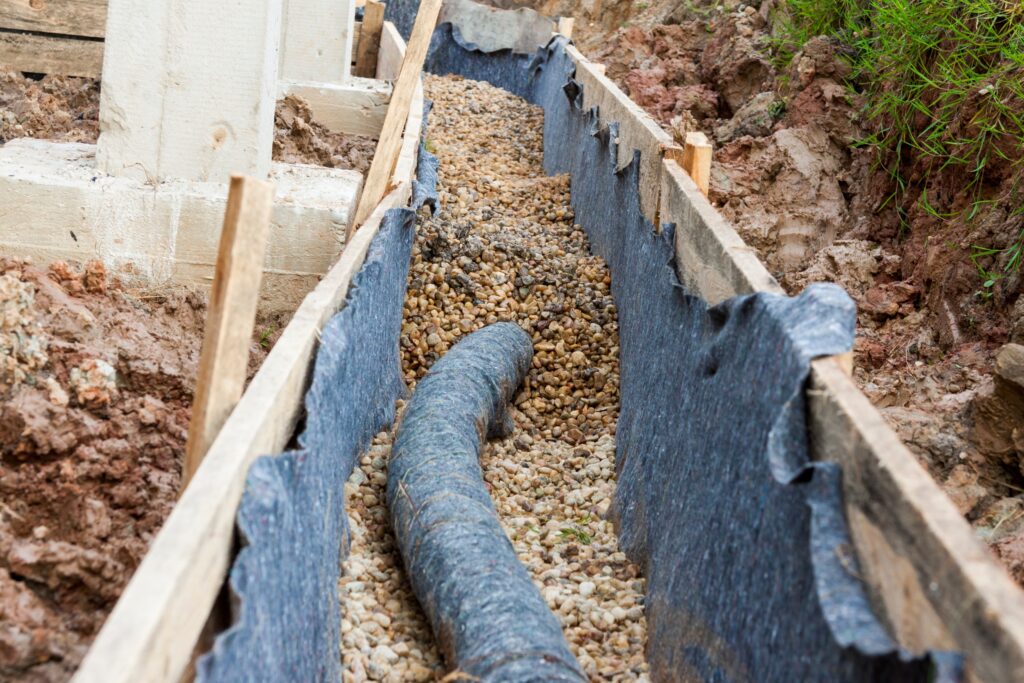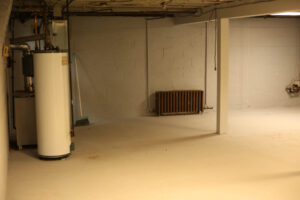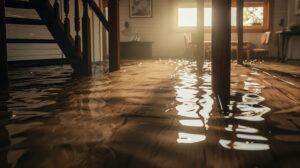A wet or flooded basement can spark a series of problems such as mold growth, property damage, cracks in the foundation, and poor indoor air quality. Some of the two popular strategies that can help keep your basement or crawl space dry are installing a French Drain or a WaterGuard interior drainage system. Although they are both effective methods that can help you manage water infiltration and prevent moisture-related issues, they differ in their design, installation, and effectiveness. In this article, we will be discussing the differences between French drain and Water guard interior drainage systems to help you make an informed decision for your specific needs.
French Drain System
French drains consist of a trench filled with rock or gravel and a perforated pipe that helps to redirect groundwater away from the foundation. A trench is dug along the perimeter of the affected area and sloped away from the structure to allow water to flow into the drain. The bottom of the trench is filled with a layer of coarse gravel before placing a perforated pipe and securing it with more gravel around and on top. A geotextile fabric is placed on top and filled with soil to allow water in and keep soil particles out. As the water seeps into the ground, it enters the perforated pipe and is directed to a drainage outlet that is far away from the property.

Which drain system is the right one for you?
WaterGuard Interior Drainage System
A waterguard is another type of waterproofing solution that is designed to effectively manage and redirect water that seeps into your basement or crawl space. A special drainage channel is installed along the perimeter of the basement floor, typically against the walls on top of the foundation footing. The drainage channel collects underground water and channels it towards a sump pump which directs the excess water away from the house. It is designed with a slight slope or gradient to direct water toward the designated drainage point. Unlike the French drains, a WaterGuard interior drainage system is installed beneath the basement floor making it relatively neat, unobtrusive, and less prone to clogs from soil and debris.
Major Differences between French Drain and WaterGuard Interior Drainage System
- Efficiency
Both systems have their strengths when it comes to efficiency. French drains are more effective at managing surface water as it prevents it from seeping into the basement. However, they might struggle with managing hydrostatic pressure that builds up under the foundation, pushing water through cracks in the floor. A WaterGuard interior drainage system is designed to effectively handle hydrostatic pressure, making it a reliable solution for basements that are prone to such issues.
- Installation
Installing a French drain system involves the excavation of the soil along the area surrounding the foundation. Not only is it labor-intensive, but also time-consuming and disruptive to landscaping. The installation of a WaterGuard interior drainage system involves minimal disruption since it is placed inside the basement. This can be a crucial consideration for homeowners who want to avoid the hassle of extensive excavation or interference with landscaping.
- Maintenance and long-term considerations
Another important factor to consider is the maintenance of both systems. French Drains require low maintenance but can sometimes have clogs in the perforated pipe or gravel. Therefore, they require regular inspection and maintenance to ensure they maintain their effectiveness. The design of a WaterGuard drainage system minimizes the risk of clogs but relies on a sump pump to remove collected water. Therefore, homeowners need to have a backup power source in case of electricity outages and also perform regular checks to ensure the sump pump is functioning correctly.
Choosing the right drainage system for you
When deciding between a French Drain and a WaterGuard interior drainage system, some of the factors you need to consider include the basement type, existing landscaping, budget, and maintenance preference. If your basement is prone to hydrostatic pressure or you want a less invasive installation option, then a WaterGuard drainage system might be the best choice for you. The interior installation of a WaterGuard also makes it more appealing if you wish to preserve the landscaping around your home. Although French drains can be more cost-effective in the short term, it is important to consider the potential long-term maintenance costs. A WaterGuard could be the most preferred option if you are willing to invest in a sump pump system and you prefer minimal maintenance.
Both French Drain and WaterGuard Interior Drainage Systems have their benefits and downsides. The decision to choose between the two all comes down to the unique characteristics of your basement, your budget, and maintenance preferences. By considering all the above factors, you can make an informed choice that will keep your basement dry and maintain the structural integrity of your home.



